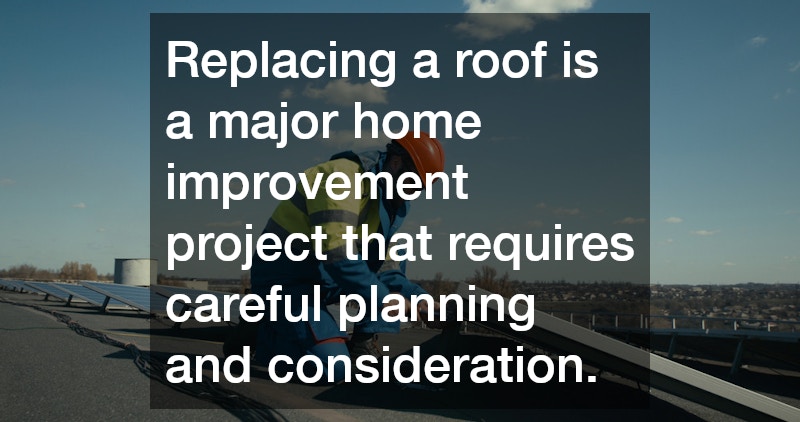Understanding the process and outcomes of a roof replacement is crucial for homeowners considering this significant investment. This article will explore common questions and provide detailed insights into what you can expect when replacing your roof.
What is the Typical Cost of Roof Replacement?
Factors Influencing Roof Replacement Cost
The cost of replacing a roof can vary widely based on several factors, including roof size, material choice, and location. For example, a larger roof area or choice of premium materials will generally increase the cost.
Geographical location also plays a significant role due to varying labor costs and regional climate considerations. Homeowners in areas prone to extreme weather may need to invest in more durable roofing materials, which can affect the overall budget. Additionally, accessibility issues such as steep slopes or complex rooflines can increase labor requirements, thereby escalating the cost. Overall, homeowners need to understand these influencing factors when planning a roof replacement.
Budgeting for Roof Replacement
Learn how to set a realistic budget for your roof replacement by considering potential hidden costs and financial options. Hidden costs might include repairs to underlying structures or disposal fees for old materials. Exploring different financial avenues, such as home improvement loans or refinancing options, can make this investment more manageable. Many homeowners choose to work with roofing specialists who offer financing plans tailored to their specific needs. A well-thought-out budget not only covers the apparent expenses but also cushions against unforeseen expenditures. By planning, homeowners can navigate the roof replacement process with financial confidence.
How Long Does a Roof Replacement Take?
Timeline for Roof Replacement
The duration of a roof replacement project depends on various elements, including weather conditions, roof complexity, and contractor efficiency. Typically, an average roof replacement can take anywhere from a few days to a week. Weather is a critical factor, as inclement conditions can prolong the timeline considerably. Homeowners should schedule the project during a clear-weather window to avoid unnecessary delays. Furthermore, the complexity of the roof design, such as multiple slopes or architectural features, can extend project time. Choosing a reputable and efficient contractor can also significantly influence the timeline.
Minimizing Disruption During Replacement
Strategies to reduce inconvenience and maintain normalcy during the roof replacement process are beneficial for homeowners. Communication with the contractor about project timelines and expected disruptions is crucial. Homeowners can also prepare by protecting valuables, removing outdoor accessories, and coordinating with the team to ensure areas of the home remain functional. These proactive measures allow for a smoother transition during the project’s duration. Additionally, some families may choose to relocate temporarily to minimize the impact of noise and dust. Discussing expectations and possible adjustments with your contractor can help streamline the roof replacement experience.
What Materials Are Available for Roof Replacement?
Overview of Roofing Material Options
Explore the range of materials available for roof replacement, including asphalt shingles, metal, tile, and more. Each material offers distinct advantages suited to different climates and aesthetic preferences. Asphalt shingles are popular due to their affordability and versatility, while metal roofs are noted for their longevity and energy efficiency. Tile roofs, although heavier and often pricier, provide a classic appearance and excellent durability. Lesser-known options like wood shingles or synthetic materials are also gaining traction for their unique aesthetics and eco-friendly attributes. Homeowners should consider both the upfront costs and long-term benefits when selecting a roofing material.
Pros and Cons of Different Roofing Materials
Detailed comparison of roofing materials to help homeowners make informed decisions based on durability, aesthetics, and cost-effectiveness. Choosing the right material is a balance between budget constraints and long-term value. Metal roofs, for instance, are highly durable but might require higher upfront costs compared to asphalt shingles. However, their longevity might translate into savings over time. On the flip side, while wood shingles offer a beautiful and natural look, they may require more maintenance compared to synthetic options. Evaluating each material’s pros and cons can help homeowners align choices with their priorities.
How to Choose the Right Roofing Contractor?
Evaluating Roofing Contractors
Key criteria and red flags to look for when selecting a roofing contractor for your replacement project. Checking references and verifying licenses are crucial first steps in the vetting process. Experience and reputation in the local community can be telltale signs of a contractor’s reliability. It’s wise to seek out those who provide clear written estimates and transparent communication. Another red flag could be significant deviations in cost estimates compared to others. A thorough evaluation can ensure that the contractor is qualified and trustworthy, safeguarding your investment.
Questions to Ask Potential Contractors
A list of crucial questions to ask prospective contractors to assess their expertise, reliability, and transparency. Inquiring about insurance coverage and warranty options is essential for peace of mind. Understanding their process for handling unforeseen issues or changes in project scope is also critical. Homeowners should also ask about the contractor’s safety measures and expected project timeline. A well-informed dialogue can illuminate a contractor’s capabilities and customer service philosophy. By asking the right questions, homeowners can forge a strong partnership with their chosen roofing professional.
Replacing a roof is a major home improvement project that requires careful planning and consideration. By understanding the process, costs, and available options, homeowners can ensure a successful and satisfying roof replacement experience.




